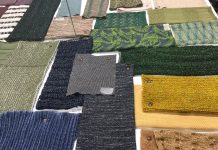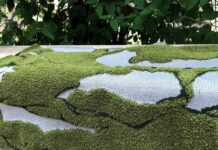Lindsay Mann reports
As an idealist, with a bleeding heart for the planet, I’m always looking for ways to support nature and to incorporate it into my life and the lives of those around me. Living in a city and being generally removed from trees, oceans, and all the best stuff this world has to offer, it undoubtedly affects our quality of life. We need nature. We are nature. The Earth gives us everything we need in abundance, and for free. Knowing that, it becomes more and more important in our current state of global turmoil that we need to make serious changes for our collective health and wellbeing.

With natural disasters occurring everywhere, climate change is undeniable. We are reminded of both our fragility and the power of nature. The Earth is going to find balance with or without us. The general lack of acknowledgement and respect, the greed, and the overproduction of polluting materials will cost us everything. That big picture can be overwhelming and leave us feeling helpless, however, if we can focus on the smaller everyday things, we can have an impact where we can. It starts with education and asking questions.

How can we be less wasteful and recycle what we have? How can we turn trash into treasure? It’s as simple as getting back to basics and getting back to our roots. We can support nature by bringing it into our daily lives.
In a previous article I shared my views on not wanting to contribute to the pollution of garment waste and my commitment to projects only associated with biodegradable or recycled materials. Since then, I’ve built a project around those beliefs and I’ve come to a point where I’ve needed to add some colour, while keeping my conscious values in line. Dyeing is new territory for me, and natural dyeing is my obvious preference, so I decided to study with an expert who shares my vision and passion for nature.

I spent an inspirational weekend studying and experimenting with natural dyes under Cara Marie Piazza, a well renowned natural dyer and textile designer. Formerly, a slave to the fashion industry-as many of us are- she had her change of heart a few years ago. This shift eventually led her to natural dyes where everything she truly loved clicked into place. She has been studying, experimenting, designing, consulting, and now teaching, ever since.
We studied bundle dyeing with flowers, plants, and herbs. We studied indigo dyeing and Shibori techniques. We also learned that certain food waste can be used for dyes. Foods like pomegranate peels, avocado pits and peels, onion peels, nuts, and citrus peels are a few examples. Distilled white vinegar and apple cider vinegar are also great for mordanting. I was floored to learn what I could make with ingredients in my kitchen.

When choosing your flowers and plants for dyeing, do your research for safety reasons but in general, if the word “tinctoria” is in the name, it dyes! All natural dyes look good together no matter how different they are and natural dyes only take to natural fibres; cellulose and protein fibres.
Synthetic black can be one of the most toxic colours to have against our skin and in our environment. Achieving black through natural dyes can be one of the more challenging and time consuming colours, but it’s worth it. Natural black can be made from the iron of rusty metals, as well as, logwood, or walnuts. Again, experimentation is key… and it’s fun!

Another fascinating component of natural dyes are the healing properties of plants, herbs, and flowers. Not only are the colours visually healing, but the actual plant properties have added benefits to our wellbeing too. This is my favourite part of it all. Goldenrod can help combat allergies, mugwort can be used as a sleep aid, calendula supports skin health, and turmeric and safflower are anti-inflammatories.

I gained lots of insight from my weekend with Piazza and look forward to not only utilizing her teachings in my own work but also encouraging the industry to consider doing the same. We can reduce our wastefulness and industrial pollution by adopting more sustainable production methods like natural dyeing. There are no excuses. These practices existed long before industry ever did anyway. Can you imagine how helpful these changes would be if they were implemented globally?

Interestingly enough, the sustainability of Piazza’s designs are actually more of a by-product of her work. Her passion lies in the alchemy, beauty, and the experimentation of using colours from flowers, food, herbs, and plants. And she loves teaching her practices, which comes through in her effortlessly vibrant personality. To learn more about Cara Marie Piazza, her intimate apparel line Calyx, or to take one of her workshops, visit her website here.
While having plants and flowers in my apartment has added significant benefits to subsiding the stress of urban life, now I’ve learned many ways to continue to add value to them long after they’re thriving. Their colours are gifts that keep on giving. This is self-sustainability in a way I’m truly grateful for. In celebration of all that nature represents, that’s how it comes full circle; naturally.

Subscribe To Our Newsletter
Join our mailing list to receive the latest news and updates from our team.














